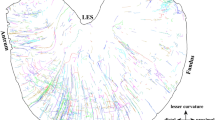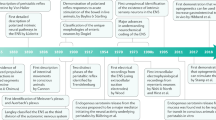Abstract
Substance P (SP) is an undecapeptide originally isolated from the gut1 and since shown to occur within neurones in several parts of the peripheral2,3 and central4 nervous systems. Immunohistochemical studies indicate an exceedingly dense network of SP-containing nerves within the myenteric plexus of the guinea pig ileum5,6. These nerves are intrinsic to the gut wall 5,7 and can release SP to contract the longitudinal muscle layer8,9. We have previously shown10,11 that SP directly depolarizes myenteric neurones and that this depolarization has a time course and ionic mechanism similar to the.slow excitatory postsynaptic potential (e.p.s.p.) which can be produced by electrical stimulation of presynaptic nerves within the myenteric ganglia. We wondered whether SP might mediate this slow synaptic potential10. We report here that the SP depolarization and the slow e.p.s.p. are reversibly depressed by chymotrypsin, an enzyme which degrades SP, although the responses to acetylcholine, serotonin and an unknown hyperpolarizing transmitter are unaffected. The results provide direct evidence that a peptide can mediate chemical transmission between neurones in the mammalian nervous system.
This is a preview of subscription content, access via your institution
Access options
Subscribe to this journal
Receive 51 print issues and online access
$199.00 per year
only $3.90 per issue
Buy this article
- Purchase on Springer Link
- Instant access to full article PDF
Prices may be subject to local taxes which are calculated during checkout
Similar content being viewed by others
References
Von Euler, U. S. & Gaddum, J. H. J. Physiol., Lond. 72, 74–87 (1931).
Nilsson, G. et al. Histochemistry 43, 97–99 (1975).
Pearse, A. G. E. & Polak, J. M. Histochemistry 41, 373–375 (1975).
Hokfelt, T. et al. in Substance P (eds Von Euler, U. S. & Pernow, B.) 117–145 (Raven, New York, 1977).
Costa, M., Cuello, C., Furness, J. B. & Franco, R. Neuroscience 5, 323–331 (1980).
Schultzberg, M. et al. Neuroscience 5, 689–744 (1980).
Franco, R., Costa, M. & Furness, J. B. Naunyn-Schmeidebergs Archs Pharmak. 307, 57–63 (1979).
Franco, R., Costa, M. & Furness, J. B. Naunyn-Schmeidebergs Archs Pharmak. 306, 185–201 (1979).
Rosell, S. et al. in Substance P (eds Von Euler, U. S. & Pernow, B.) 83–88 (Raven, New York, 1977).
Katayama, Y. & North, R. A. Nature 274, 387–388 (1978).
Katayama, Y., North, R. A. & Williams, J. T. Proc. R. Soc. B206, 191–208 (1979).
Nishi, S. & North, R. A. J. Physiol., Lond. 231, 471–491 (1973).
Hirst, G. D. S., Holman, M. E. & Spence, I. J. Physiol., Lond. 236, 303–326 (1974).
Johnson, S. M., Katayama, Y. & North, R. A. J. Physiol., Lond. 301, 505–516 (1980).
Chang, M. M. & Leeman, S. E. J. biol. Chem. 254, 4784–4790 (1971).
Wood, J. D. & Mayer, C. J. Nature 276, 836–837 (1979).
Johnson, S. M., Katayama, Y. & North, R. A. J. Physiol., Lond. (in the press).
Author information
Authors and Affiliations
Rights and permissions
About this article
Cite this article
Morita, K., North, R. & Katayama, Y. Evidence that substance P is a neurotransmitter in the myenteric plexus. Nature 287, 151–152 (1980). https://doi.org/10.1038/287151a0
Received:
Accepted:
Issue Date:
DOI: https://doi.org/10.1038/287151a0
This article is cited by
-
Effect of bombesin and substance P on the smooth muscle of the chicken crop
Veterinary Research Communications (1988)
-
Antigenic components of human glioblastoma multiforme and rat C6 glioma using monoclonal antibodies
Journal of Biosciences (1987)
-
A pharmacological and immunohistochemical study of the splanchnic innervation of ileal longitudinal muscle in the toad Bufo marinus
Naunyn-Schmiedeberg's Archives of Pharmacology (1986)
-
The cyclic motor activity of the ovine gut: its reset at a faster rhythm
Experientia (1984)
Comments
By submitting a comment you agree to abide by our Terms and Community Guidelines. If you find something abusive or that does not comply with our terms or guidelines please flag it as inappropriate.



